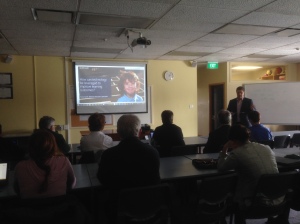This post was guest written by Mr Ben Hilliam after St Andrew’s College hosted Mr Travis Smith, Microsoft Australia’s National Education Specialist in December 2014.
In December 2014, St Andrew’s College had the privilege of hosting Microsoft Australia’s National Education Specialist, Travis Smith. He spent a week touring New Zealand talking to educators from primary through to tertiary sectors about how they can use technology to improve learning outcomes. Although this sounds like an arbitrary topic for a speaker from Microsoft, Travis focussed continually on how improved learning takes place and the technology was very much an accompanying instrument to this drive.
Travis spoke very broadly at first about how we need to target where we want to see innovation in using digital technology, otherwise, schools’ pedagogical progress can be flapped about by what any particular teacher wants to focus on at any time. The challenge is to get 80%+ of your educators being actively innovative in their practice. A hurdle that Travis identified to this goal is the way we educate our educators.
As teachers we can be quite innovative with the way we teach content and facilitate inquiry for our students, but ask us to do the same for our co-workers and we get into lecture mode. Travis suggests that when it comes to getting educators to become innovative in their practice:
- They first need to become familiar with the technology they are going to use.
- Secondly they need to develop a skills base with that technology.
- Then finally, they need to have be given the time and opportunity to implement it into their learning/teaching processes.
That three step process seems simple, however, most school professional development opportunities miss out steps 1 and 2 and jump straight to 3.
The technology that Travis spoke at length about in his presentation, is one dear to my own professional development: The Power of the Pen. We have been in an era of digital technology for 40+ years now. Computers have been in schools in some way or another for well over 30 years. For the last 20 years every high school student by the time they have left school has spent quite some time using a computer. And now probably the majority of schools run some kind of BYOD or 1-1 computer programme. However, for certain aspects of learning, digital technologies have made very little progress on changing or adapting the way they are taught. My subject area, Mathematics, being one of the main unaffected areas. The reason for this is because many types of thinking are best supported by pen and paper. Travis cites this research in support of this.
Personal Reflections On Using A Pen In Mathematics Teaching:
I would like to reflect on how my innovation process worked with my adoption of the pen (or stylus) and Microsoft SurfacePro when incorporating digital technologies into teaching and learning:
- Becoming familiar with the technology: As I sit and write this post at my parents-in-law’s house during my summer break, it is here where three years ago, my brother-in-law showed me his iPad with a stylus. I had a play around with an app called Paper. The stylus was quite good with the iPad, but had the drawback of not working when your palm rested on the screen. However, it was enough to whet my appetite and I could immediately see the advantage of a digital canvas in a world with cloud sharing. I convinced my school to let me be a forerunner with this technology and after I put the case to them, they invested in an iPad and stylus for me to use in my classes.
- Building skills with the technology: My iPad became my new whiteboard and notebook. I could cast my screen to my projector, deliver my content that way, and still have a copy to share with my students afterwards. I still had the frustration of having to have a magazine between my palm and the screen, but I felt I was moving in the right direction and feedback and marks from my students did not contradict me. I moved to a new school (St Andrew’s College) which was Microsoft only, so I needed to adapt. They provided me with a SurfacePro and I continued as I had with the iPad with some added advantages: I could now write naturally with my palm on the screen, my notes were always live and organised through Microsoft OneNote and I had a fully-fledged computer at my fingertips. Here is an example of how I used it.
- Implementing technology into my teaching and learning process: I am now able to approach 2015 running, with three of my classes now in a 1-1 computing environment. My students can have their learning their own way, either my “chalk and talk” projected in class, or watched again afterwards having been recorded and posted using OfficeMix or in some cases watch content in advance. On their own devices they all have a communal OneNote along with their own personal OneNotes that I have access to as well. And for those students also with a stylus enabled device such as a Microsoft SurfacePro or a Lenovo Yoga, they can toss their paper books aside.
As I reflect on how this process has played out for me, I can see I have built an innovative practice into my everyday pedagogy and it is now embedded. However, this whole process has taken around two years and required support from my successive HOD’s, senior managers and IT staff. If schools want to emulate this process they first need to create an environment where these things can all come together.
Further Information:
To watch a similar presentation to the one Travis presented at St Andrew’s College, watch the YouTube clip below:

